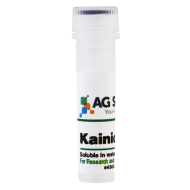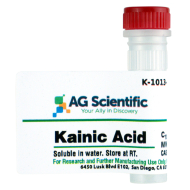OVERVIEW Kainic Acid is a marine product, derived from the red marine alga Digenea Simplex. Kainic Acid is an excitatory amino acid receptor agonist selective for kainate receptor subtype; conformationally restricted analog of L-glutamic acid. Kainic acid is a potent central nervous system stimulant, and has been developed as the prototype neuroexcitatory amino acid for the induction of seizures in experimental animals, at a typical dose of 10-30 mg/kg in mice. Kainic acid is neuroexcitotoxic and epileptogenic, acting through specific kainate receptors.
OVERVIEW Kainic Acid is a marine product, derived from the red marine alga Digenea Simplex. Kainic Acid is an excitatory amino acid receptor agonist selective for kainate receptor subtype; conformationally restricted analog of L-glutamic acid. Kainic acid is a potent central nervous system stimulant, and has been developed as the prototype neuroexcitatory amino acid for the induction of seizures in experimental animals, at a typical dose of 10-30 mg/kg in mice. Kainic acid is neuroexcitotoxic and epileptogenic, acting through specific kainate receptors.
RAT BRAIN EXPERIMENTATION Kainic acid (KA) is an agonist for a subtype of ionotropic glutamate receptor, and administration of KA has been shown to increase production of reactive oxygen species, mitochondrial dysfunction, and apoptosis in neurons in many regions of the brain, particularly in the hippocampal subregions of CA1 and CA3, and in the hilus of dentate gyrus (DG). Examining the kainic acid-induced changes of mRNA levels of several cytokines such as IL-1 beta, IL-6, TNF and LIF in the rat brain regions using semiquantitative RT-PCR method, it was found that IL-1 beta mRNA was markedly increased in the cerebral cortex (CC), thalamus (THL) and hypothalamus (HT) 2 h after the injection of kainic acid in a convulsive dose (12 mg/kg i.p.), and tended to decrease 4 h after the injection. IL-6 mRNA was weakly induced in the hippocampus (HPP) 2 h after the injection of kainic acid and was markedly increased in the CC, HPP, THL, and HT at 4 h. The level of TNF mRNA was highly elevated in the CC, HPP, striatum (STR), THL and HT at 2 and 4 h after the injection. LIF mRNA apparently expressed in the CC and HPP of control rats and was increased in the CC, HPP and HT by the treatment with kainic acid. These results indicate that mRNAs of several cytokines are increased in various brain regions with different time-courses by kainic acid Sources: Masabumi Minami, Yasushi Kuraishi, Masamichi Satoh

